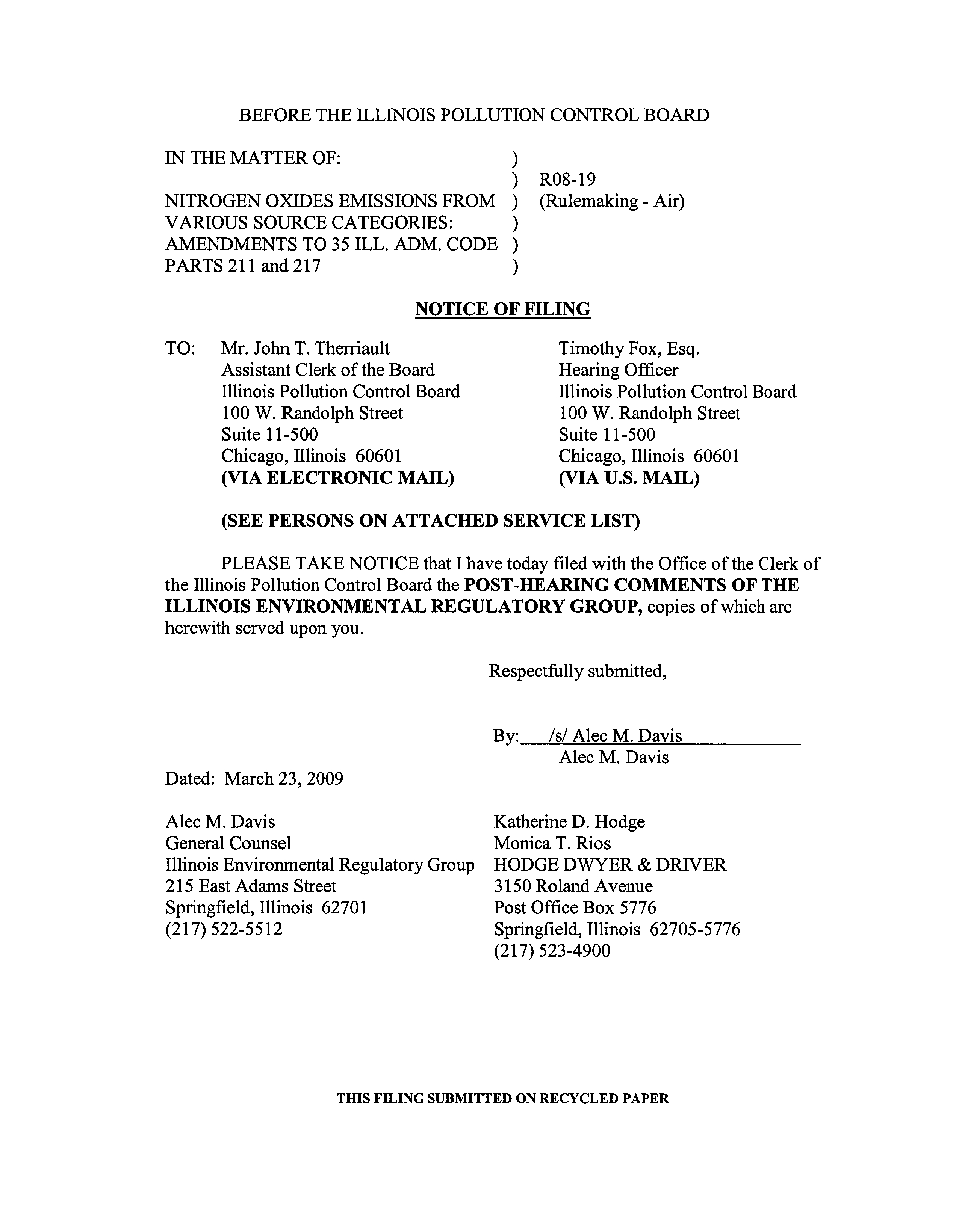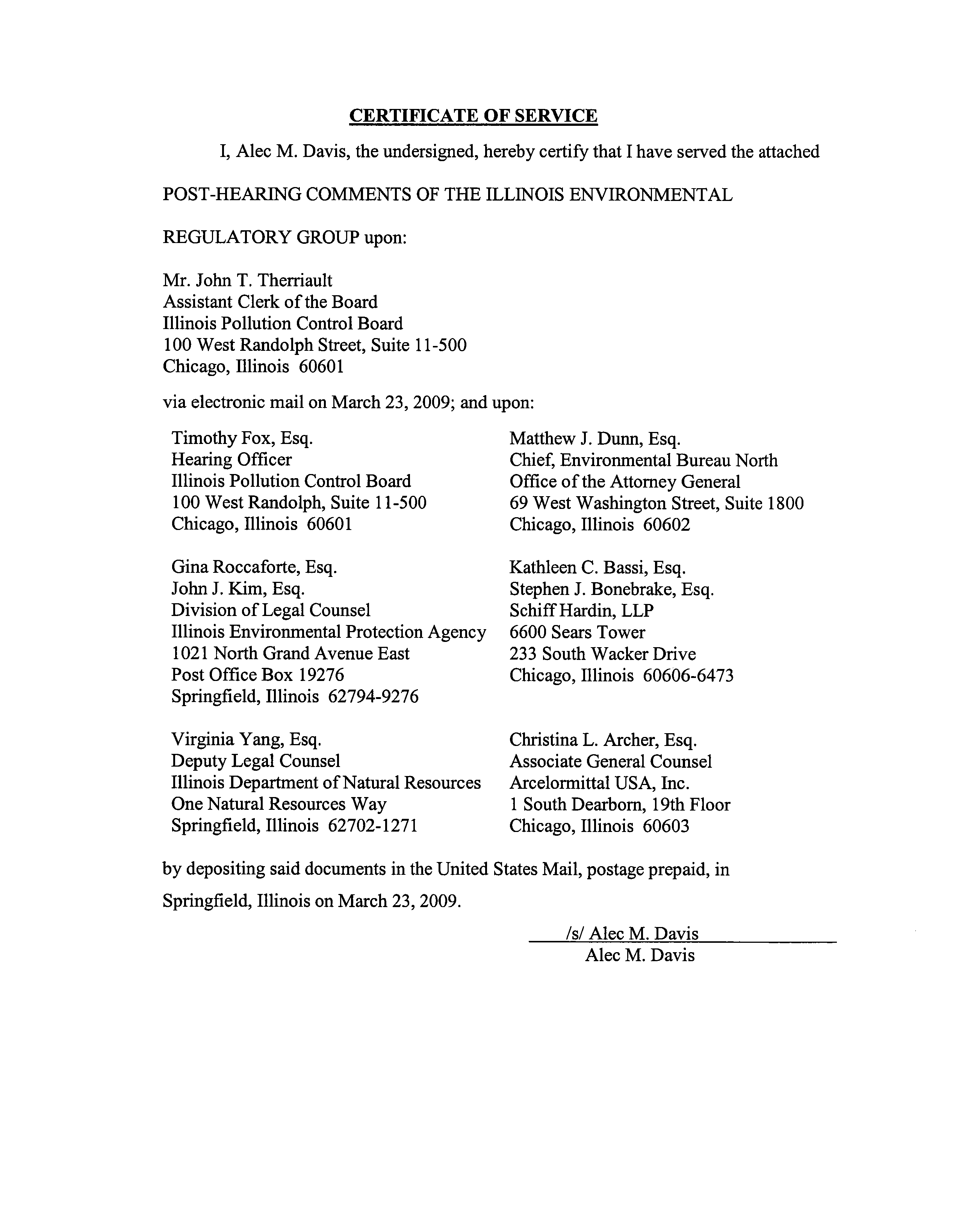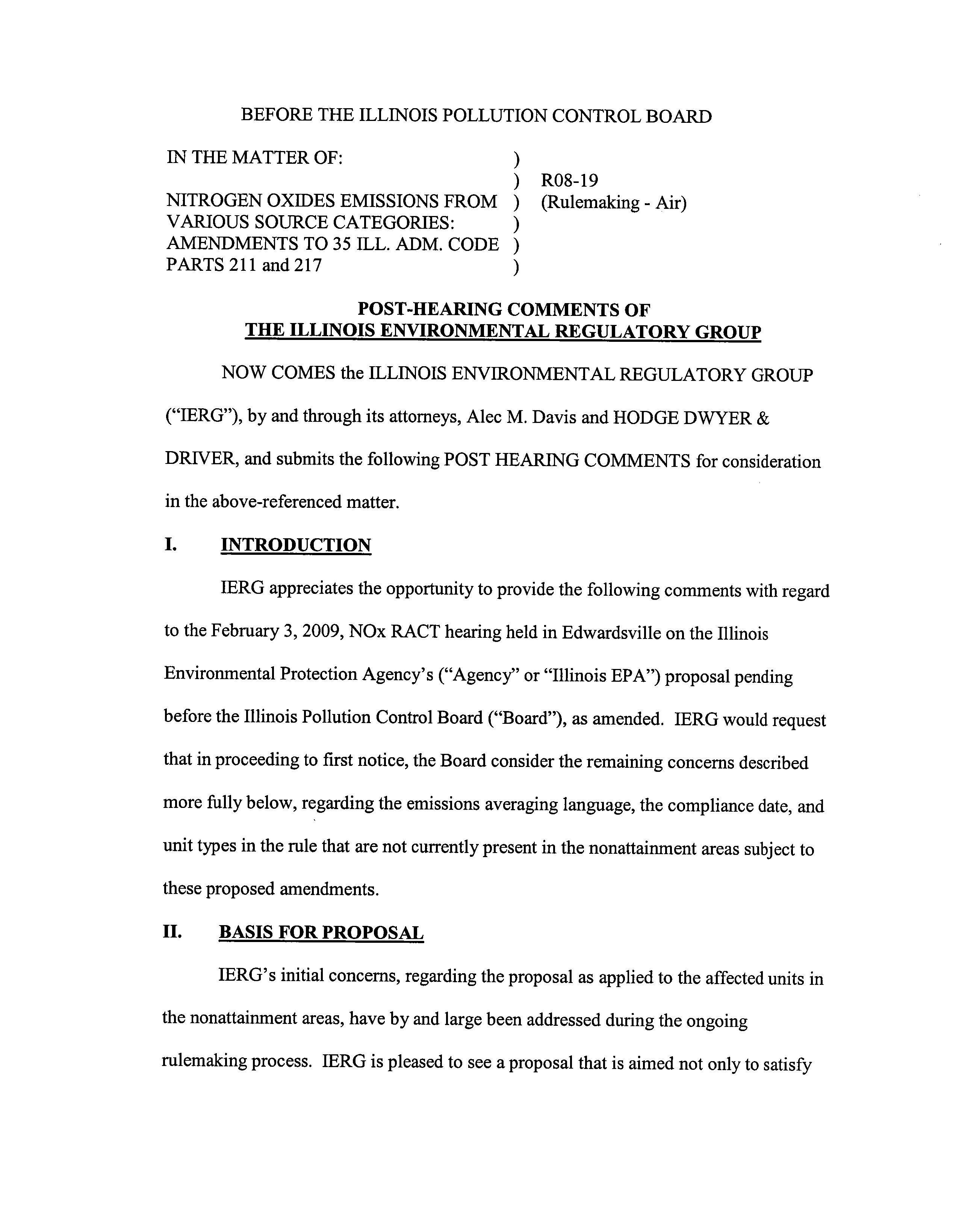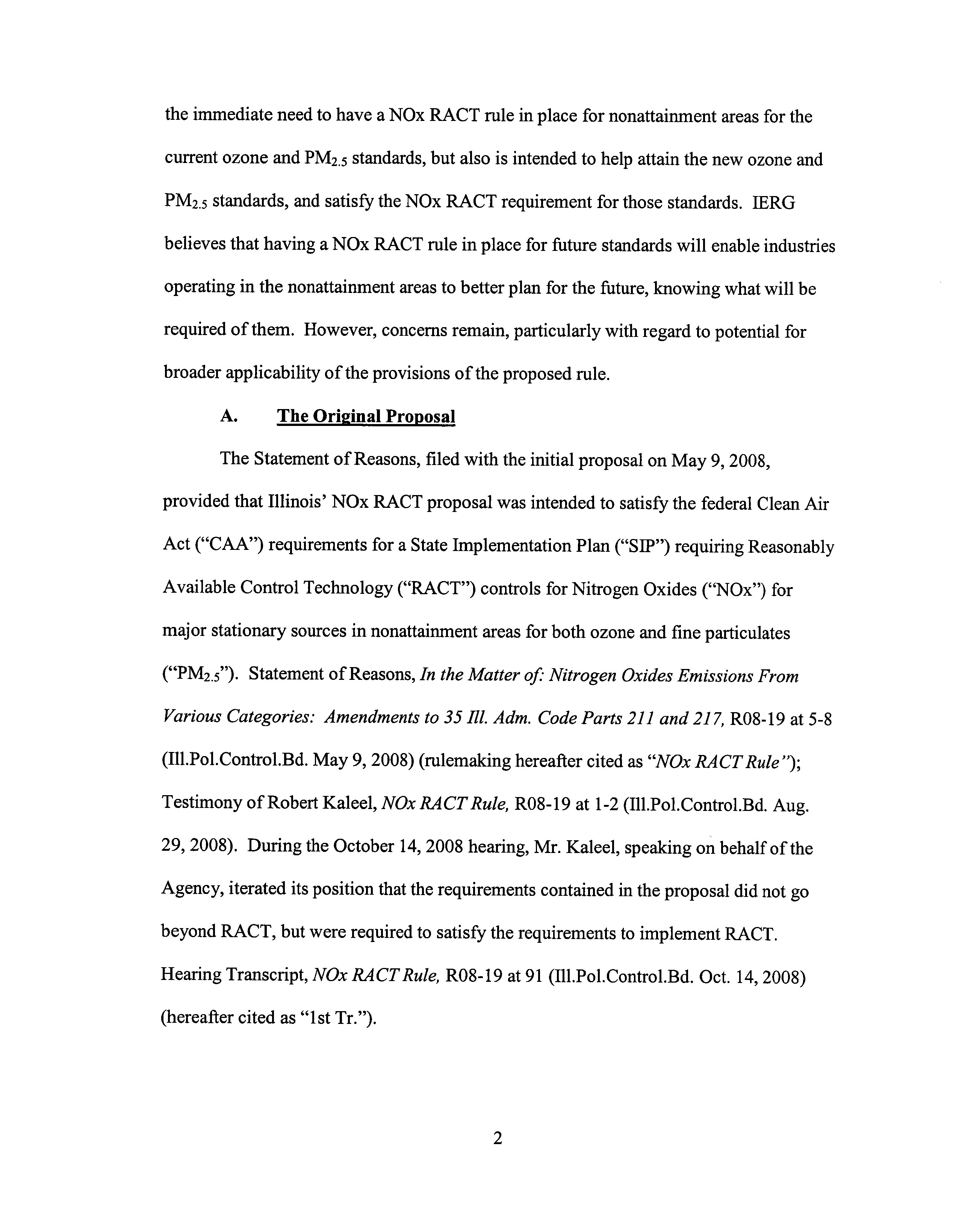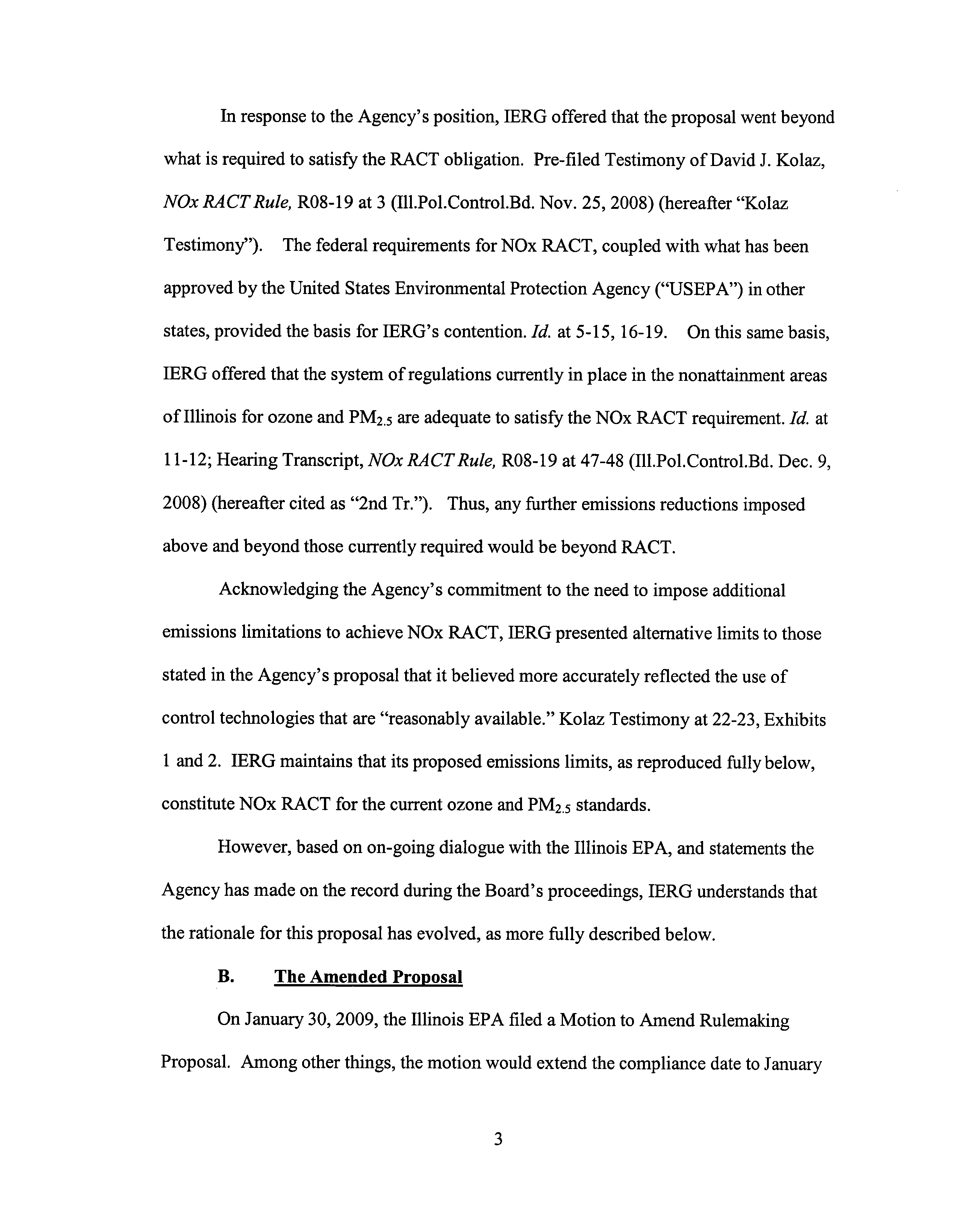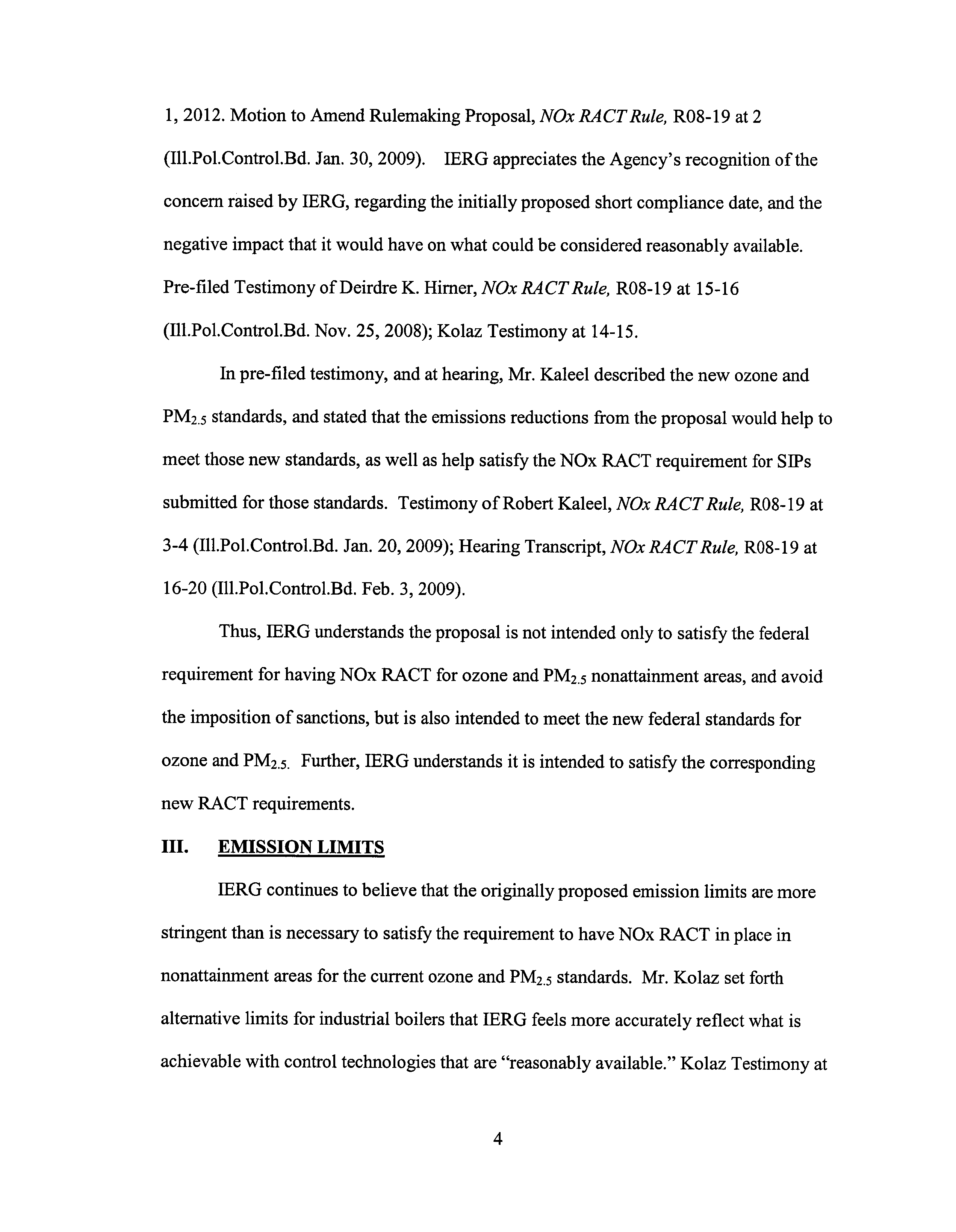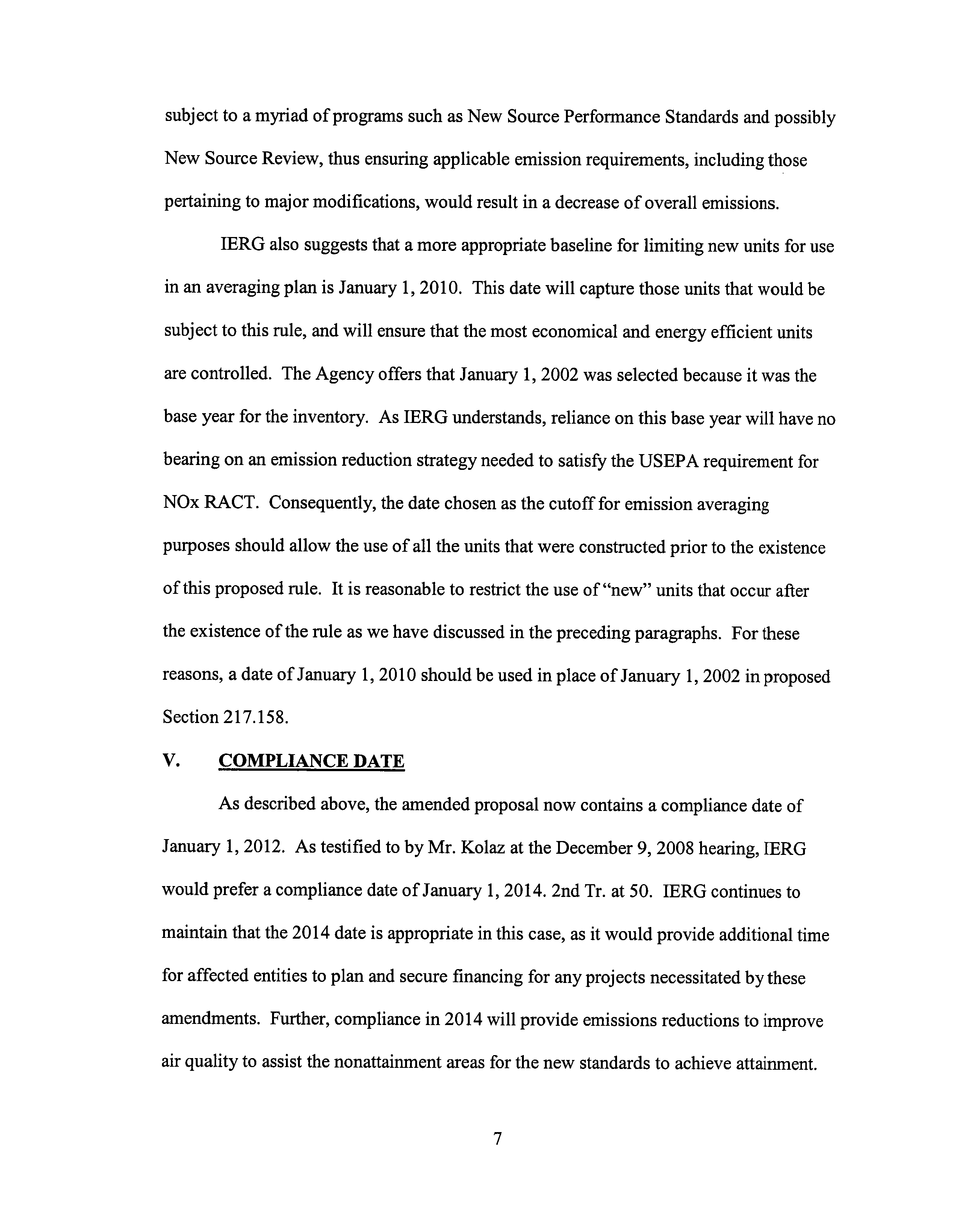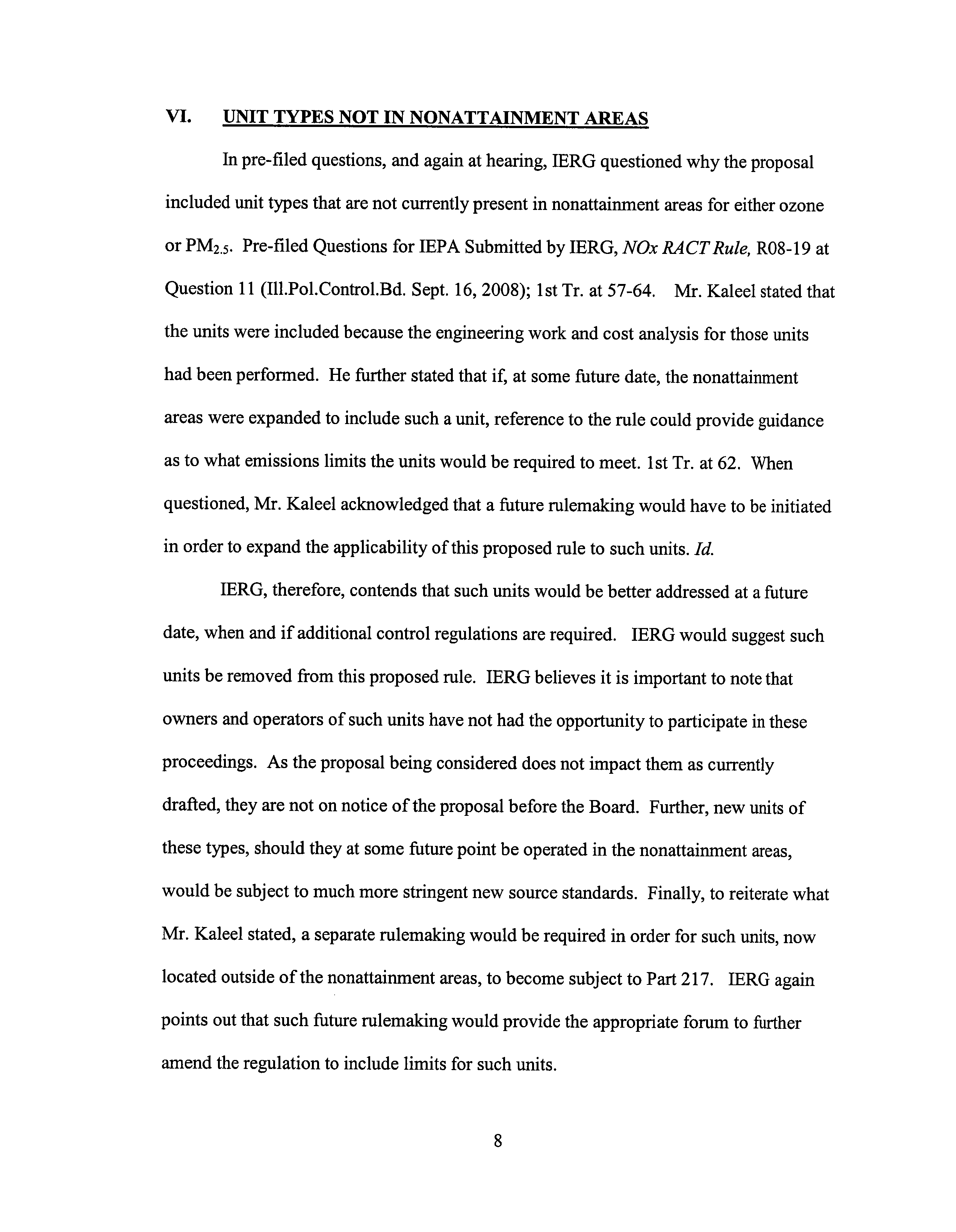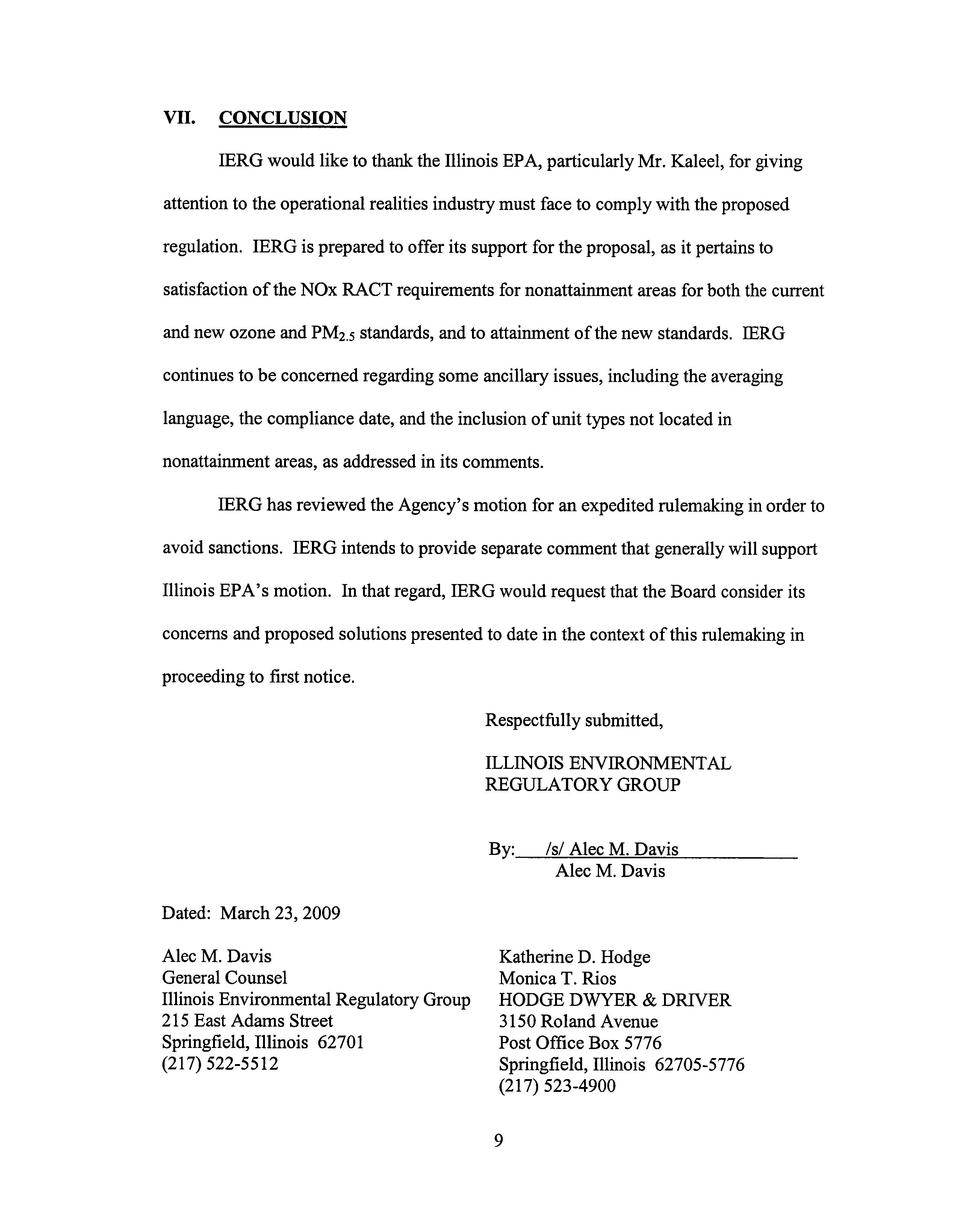BEFORE THE ILLINOIS POLLUTION CONTROL BOARD
IN THE MATTER OF:
)
NITROGEN OXIDES EMISSIONS FROM )
VARIOUS SOURCE CATEGORIES: )
AMENDMENTS TO 35 ILL. ADM. CODE )
PARTS 211 and 217
)
R08-19
(Rulemaking - Air)
NOTICE OF FILING
TO: Mr. John T. Therriault
Assistant Clerk of the Board
Illinois Pollution Control Board
100 W. Randolph Street
Suite 11-500
Chicago,
Illinois 60601
(VIA ELECTRONIC MAIL)
Timothy Fox, Esq.
Hearing Officer
Illinois Pollution
Control
Board
100 W. Randolph Street
Suite 11-500
Chicago,
Illinois
60601
(VIA
U.S.
MAIL)
(SEE PERSONS ON ATTACHED SERVICE LIST)
PLEASE TAKE NOTICE that I have today filed with the
Office
of the
Clerk
of
the Illinois Pollution Control Board the POST-HEARING COMMENTS OF THE
ILLINOIS
ENVIRONMENTAL REGULATORY GROUP, copies of which are
herewith served upon you.
Respectfully submitted,
By: /s/ Alec M. Davis
Alec M. Davis
Dated: March 23, 2009
Alec M. Davis
General Counsel
Illinois Environmental Regulatory Group
215 East Adams
Street
Springfield, Illinois 62701
(217) 522-5512
Katherine D. Hodge
Monica T. Rios
HODGE DWYER & DRIVER
3150
Roland
Avenue
Post Office Box 5776
Springfield, Illinois 62705-5776
(217) 523-4900
THIS FILING SUBMITTED ON RECYCLED PAPER
Electronic Filing - Received, Clerk's Office, Mrch 23, 2009
* * * PC # 13 * * * * *
CERTIFICATE OF SERVICE
I, Alec M. Davis, the undersigned, hereby certify that I have served the attached
POST-HEARING COMMENTS
OF
THE ILLINOIS ENVIRONMENTAL
REGULATORY GROUP upon:
Mr. John T. Therriault
Assistant Clerk of the Board
Illinois Pollution Control Board
100
West
Randolph
Street, Suite 11-500
Chicago, Illinois 60601
via electronic mail on March 23, 2009; and upon:
Timothy Fox, Esq.
Hearing Officer
Illinois Pollution
Control Board
100 West Randolph, Suite 11-500
Chicago, Illinois 60601
Matthew J. Dunn, Esq.
Chief, Environmental Bureau
North
Office of the Attorney General
69
West Washington Street, Suite 1800
Chicago, Illinois 60602
Gina
Roccaforte,
Esq.
John J. Kim, Esq.
Division of Legal Counsel
Illinois Environmental Protection Agency
1021
North Grand Avenue East
Post Office Box 19276
Springfield, Illinois 62794-9276
V
irginia Yang, Esq.
Deputy Legal
Counsel
Illinois Department of Natural Resources
One Natural Resources Way
Springfield, Illinois 62702-1271
Kathleen C. Bassi, Esq.
Stephen J.
Bonebrake,
Esq.
Schiff Hardin, LLP
6600 Sears Tower
233 South Wacker Drive
Chicago, Illinois 60606-6473
Christina L. Archer, Esq.
Associate General Counsel
Arcelormittal
USA, Inc.
1 South Dearborn, 19th Floor
Chicago, Illinois 60603
by depositing said documents in the
United States
Mail, postage
prepaid, in
Springfield, Illinois on March 23, 2009.
/s/ Alec M. Davis
Alec M. Davis
Electronic Filing - Received, Clerk's Office, Mrch 23, 2009
* * * PC # 13 * * * * *
BEFORE THE
ILLINOIS POLLUTION CONTROL
BOARD
IN
THE MATTER OF:
)
R08-19
NITROGEN
OXIDES EMISSIONS FROM ) (Rulemaking -
Air)
VARIOUS SOURCE CATEGORIES:
)
AMENDMENTS
TO 35 ILL. ADM.
CODE
)
PARTS 211
and 217
)
POST-HEARING
COMMENTS
OF
THE ILLINOIS ENVIRONMENTAL
REGULATORY
GROUP
NOW COMES the ILLINOIS
ENVIRONMENTAL REGULATORY
GROUP
("IERG"),
by and through its attorneys,
Alec M. Davis and HODGE DWYER
&
DRIVER, and submits the following
POST HEARING
COMMENTS for consideration
in the
above-referenced matter.
I. INTRODUCTION
IERG
appreciates the opportunity to provide
the following comments
with regard
to the February 3, 2009,
NOx RACT hearing held in Edwardsville
on the Illinois
Environmental Protection
Agency's ("Agency"
or "Illinois EPA") proposal pending
before the Illinois Pollution
Control Board ("Board"), as amended.
IERG would request
that in proceeding
to first notice, the Board consider
the remaining concerns
described
more fully below, regarding the
emissions averaging language,
the compliance date, and
unit types in
the rule that are not currently present
in the nonattainment
areas subject to
these proposed amendments.
II.
BASIS FOR PROPOSAL
IERG's initial concerns,
regarding the proposal as
applied to the affected
units in
the nonattainment
areas, have by and large been
addressed during the ongoing
rulemaking
process. IERG is pleased
to see a proposal that is
aimed not only to satisfy
Electronic Filing - Received, Clerk's Office, Mrch 23, 2009
* * * PC # 13 * * * * *
the immediate need to have
a NOx RACT rule in place for nonattainment
areas for the
current
ozone and PM2.5 standards, but also is intended
to help attain the new ozone and
PM2.5 standards,
and satisfy the NOx RACT requirement for those standards.
IERG
believes that having a NOx RACT rule in place
for future standards will enable industries
operating in the nonattainment
areas to better plan for the future, knowing
what will be
required
of them. However, concerns remain, particularly
with regard to potential for
broader applicability of the provisions
of the proposed rule.
A. The Original Proposal
The Statement of Reasons,
filed with the initial proposal on May
9, 2008,
provided that
Illinois' NOx RACT proposal was intended
to satisfy the federal Clean Air
Act
("CAA") requirements for a
State
Implementation
Plan ("SIP") requiring
Reasonably
Available Control Technology
("RACT") controls for Nitrogen
Oxides ("NOx") for
major stationary sources in nonattainment
areas for both ozone and fine
particulates
("PM2.5"). Statement
of Reasons, In the Matter of.-
Nitrogen Oxides Emissions From
Various Categories: Amendments
to 35 Ill. Adm. Code Parts 211 and 217, R08-19
at 5-8
(I11.Pol.Control.Bd.
May 9, 2008) (rulemaking hereafter
cited as "NOx RACT Rule ");
Testimony of Robert Kaleel, NOx RACT Rule,
R08-19 at 1-2 (I11.Pol.Control.Bd.
Aug.
29, 2008). During
the October 14, 2008 hearing, Mr. Kaleel,
speaking on behalf of the
Agency,
iterated its position that the requirements
contained in the proposal
did not go
beyond RACT, but were
required to satisfy the requirements
to implement RACT.
Hearing
Transcript, NOx RA CT Rule, R08-19
at 91 (I11.Pol.Control.Bd.
Oct.
14,
2008)
(hereafter cited
as "1st Tr.").
Electronic Filing - Received, Clerk's Office, Mrch 23, 2009
* * * PC # 13 * * * * *
In response
to the Agency's position, IERG offered that the proposal went beyond
what is required to satisfy the RACT obligation. Pre-filed Testimony of David
J. Kolaz,
NOx RACT Rule, R08-19 at 3 (I11.Pol.Control.Bd.
Nov. 25, 2008) (hereafter "Kolaz
Testimony").
The federal requirements for NOx RACT, coupled
with what has been
approved by the United States Environmental Protection
Agency ("USEPA") in other
states,
provided the basis for IERG's contention. Id. at 5-15, 16-19.
On this same basis,
IERG offered that the system of regulations currently in place
in the nonattainment areas
of Illinois for
ozone and PM2.5 are adequate to satisfy the NOx RACT requirement. Id. at
11-12; Hearing Transcript, NOx RACT Rule, R08-19
at 47-48 (I11.Pol.Control.Bd. Dec. 9,
2008) (hereafter
cited as "2nd Tr."). Thus, any further emissions reductions imposed
above and beyond those currently required
would be beyond RACT.
Acknowledging
the Agency's commitment to the need to impose additional
emissions limitations to achieve NOx RACT, IERG
presented alternative limits to those
stated in the Agency's
proposal that it believed more accurately reflected the
use of
control technologies that are "reasonably available." Kolaz Testimony
at 22-23, Exhibits
1 and 2. IERG maintains
that its proposed emissions limits, as reproduced fully
below,
constitute
NOx RACT for the current ozone and PM2.5 standards.
However, based
on on-going dialogue with the Illinois EPA, and statements
the
Agency
has made on the record during the Board's proceedings,
IERG understands that
the rationale for
this proposal has evolved, as more fully described below.
B. The Amended Proposal
On January 30, 2009, the Illinois
EPA filed a Motion to Amend Rulemaking
Proposal.
Among other things, the motion would extend the
compliance date to January
Electronic Filing - Received, Clerk's Office, Mrch 23, 2009
* * * PC # 13 * * * * *
1, 2012. Motion to Amend Rulemaking Proposal,
NOx
RACT
Rule, R08-19 at 2
(I1l.Pol.Control.Bd. Jan. 30, 2009).
IERG appreciates the Agency's recognition of the
concern raised by IERG, regarding the initially proposed short compliance
date, and the
negative impact that it would have
on what could be considered reasonably available.
Pre-filed
Testimony of Deirdre K. Hirner, NOx RACT Rule, R08-19
at 15-16
(I11.Pol.Control.Bd.
Nov. 25, 2008); Kolaz Testimony at 14-15.
In pre-filed testimony, and at hearing, Mr. Kaleel
described the new ozone and
PM2.5 standards, and stated
that the emissions reductions from the proposal would help to
meet
those new standards, as well as help satisfy the
NOx RACT requirement for SIPs
submitted for those standards. Testimony
of Robert Kaleel, NOx RACT Rule, R08-19
at
3-4
(I11.Pol.Control.Bd.
Jan. 20, 2009); Hearing Transcript,
NOx RACT Rule, R08-19 at
16-20 (I11.Pol.Control.Bd. Feb. 3, 2009).
Thus,
IERG understands the proposal is not intended
only to satisfy the federal
requirement for having NOx RACT for
ozone and PM2.5 nonattainment areas, and
avoid
the imposition
of sanctions, but is also intended to meet the new federal
standards for
ozone and PM2.5. Further, IERG
understands it is intended to satisfy the corresponding
new RACT requirements.
III. EMISSION
LIMITS
IERG
continues to believe that the originally proposed
emission limits are more
stringent than is necessary to
satisfy the requirement to have NOx RACT in place in
nonattainment
areas for the current ozone and PM2.5 standards.
Mr. Kolaz set forth
alternative limits for industrial boilers that IERG
feels more accurately reflect what is
achievable with control
technologies that are "reasonably available."
Kolaz Testimony at
Electronic Filing - Received, Clerk's Office, Mrch 23, 2009
* * * PC # 13 * * * * *
22-23
and Exhibit 1. For the Board's convenience,
those alternative limits are
reproduced below:
FUEL
TYPE
EMISSION LIMIT
(lbs/mmBtu)
Natural
Gas
or >100
mmBtu/hr
0.12
Other Gaseous <100
mmBtu/hr
Combustion Tuning
Fuels
Auxiliary boiler at EGU,
oil or natural
gas, <_250 mmBtu/hr, <_20%
capacity
Exempt
factor
Distillate
Fuel >100 mmBtu/hr
0.20
Oil
<_100 mmBtu/hr
Combustion
Tuning
Auxiliary boiler
at EGU, oil or natural
gas, <_250 mmBtu/hr,
_<20% capacity
Exempt
factor
Other Liquid
>100 mmBtu/hr
0.20
Fuels
<100 mmBtu/hr
Combustion Tuning
Auxiliary
boiler at EGU, oil or natural
gas,
<250
mmBtu/hr,
<20% capacity
Exempt
factor
Solid Fuel >100 mmBtu/hr
0.12
(circulating fluidized bed)
>250 mmBtu/hr
0.38
>100
mmBtu/hr,
0.38
<250 mmBtu/hr
<100 mmBtu/hr
Combustion Tuning
IV. AVERAGING LANGUAGE
The Agency's
proposed rule includes
a provision for demonstrating compliance
through
the use of an emissions averaging
plan. See proposed
Section 217.158. IERG
supports this concept.
Section 217.158(a) of Subpart
C (NOx General Requirements)
of the proposed
rule allows such averaging
for emission units subject to
Subpart D (industrial boilers),
E
(process heaters),
F (glass melting furnaces),
G (cement and lime kilns),
H (iron and steel
and aluminum manufacturing),
M (electrical generating
units), or Q (stationary internal
combustion
engines and turbines). IERG
would request that the Board
note that Subpart
Electronic Filing - Received, Clerk's Office, Mrch 23, 2009
* * * PC # 13 * * * * *
Q, the subject of R07-19, also contains an
emission averaging provision in Section
217.390 (Emission Averaging
Plans). IERG believes that the averaging provisions of
Sections 217.158 and 217.390 should be substantively the same, and
for clarity should be
contained in Section 217.158
(Emission Averaging Plans) of Subpart C (NOx
General
Requirements).
IERG has provided comments
regarding the emission averaging plan provisions
in
Subpart Q (R07-19), and maintained this position in its questioning
of Agency
witnesses in this proceeding regarding
the averaging provisions of Section 217.158.
Illinois
Environmental Protection Agency's Answers to Pre-filed
Questions by the
Illinois Environmental Regulatory
Group, NOx RACT Rule, R08-19 at 8
(I11.Pol.Control.Bd.
Sept. 30, 2008); 1st Tr. at 79-83.
Consequently, IERG requests that
the following language be used as the second
sentence in Section 217.158(a)(1)(C):
The new unit or units must be used for the same
purpose having
substantially
equivalent or less process capacity, or the new unit
or units
must be permitted for less
NOx emissions on an annual basis than the
actual NOx emissions of the unit or
units that are replaced.
IERG requests
this change to facilitate the averaging plan's promotion
of
environmental benefit and energy efficiency. Illinois
EPA's provision states that new
units cannot participate in
averaging unless they are "used for the same purpose"
as the
units they are replacing. The scope of the restriction, "used
for the same purpose," is
difficult to determine
from the language of the proposed rule and the
Agency's testimony.
IERG's proposed language addresses this concern
and provides suitable limitations to
allow facilities
to find creative solutions to meet their operational needs,
while
maximizing energy efficiency and minimizing present
and future environmental concerns
pertinent to emissions
such as greenhouse gases. Further, any new unit would likely
be
Electronic Filing - Received, Clerk's Office, Mrch 23, 2009
* * * PC # 13 * * * * *
subject to a myriad of programs such as
New Source Performance Standards and possibly
New Source Review, thus
ensuring applicable emission requirements, including
those
pertaining to major modifications, would result in a decrease
of overall emissions.
IERG also suggests
that a more appropriate baseline for limiting new units for
use
in an averaging plan
is January 1, 2010. This date will capture
those units that would be
subject to this rule, and will
ensure that the most economical and energy efficient
units
are
controlled. The Agency offers that January 1, 2002
was selected because it was the
base year for the inventory.
As IERG understands, reliance on this base year
will
have
no
bearing
on an emission reduction strategy needed to
satisfy the USEPA requirement for
NOx RACT. Consequently, the
date chosen as the cutoff for emission averaging
purposes
should allow the use of all the units that were
constructed prior to the existence
of this proposed rule. It is reasonable
to restrict the use of "new" units that occur
after
the existence
of the rule as we have discussed in the preceding
paragraphs. For these
reasons, a date of January 1, 2010 should
be used in place of January 1, 2002 in proposed
Section 217.158.
V. COMPLIANCE
DATE
As described
above, the amended proposal now contains
a compliance date of
January 1, 2012. As testified to by
Mr. Kolaz at the December 9, 2008 hearing,
IERG
would prefer a
compliance date of January 1, 2014. 2nd Tr.
at 50. IERG continues to
maintain that the 2014 date is appropriate
in this case, as it would provide additional
time
for affected entities
to plan and secure financing for any projects
necessitated by these
amendments. Further, compliance in 2014 will provide
emissions reductions to improve
air quality to assist the nonattainment
areas for the new standards
to achieve attainment.
Electronic Filing - Received, Clerk's Office, Mrch 23, 2009
* * * PC # 13 * * * * *
VI. UNIT TYPES NOT IN NONATTAINMENT
AREAS
In pre-filed questions,
and again at hearing, IERG questioned
why the proposal
included unit
types that are not currently present in nonattainment
areas for either ozone
or PM2.5. Pre-filed Questions
for IEPA Submitted by IERG,
NOx RACT Rule, R08-19 at
Question 11
(I11.Po1.Control.Bd. Sept.
16,2008); 1st Tr. at 57-64. Mr. Kaleel stated
that
the units were included because
the engineering work and cost analysis for
those units
had been performed.
He further stated that if,
at some future date, the nonattainment
areas were expanded to include such
a unit, reference to the rule could
provide guidance
as to what emissions
limits the units would be required
to meet. 1 st Tr. at 62. When
questioned, Mr. Kaleel acknowledged
that a future rulemaking would have
to be initiated
in order to
expand the applicability of this proposed
rule to such units. Id.
IERG, therefore, contends that
such units would be better addressed
at a future
date, when
and if additional control regulations are required.
IERG would suggest such
units be removed from this proposed
rule. IERG believes it is important
to note that
owners and operators
of such units have not had the
opportunity to participate in these
proceedings. As the proposal
being considered does not impact
them as currently
drafted, they are
not on notice of the proposal before
the Board. Further, new units
of
these types, should they at some
future point be operated in the nonattainment
areas,
would be subject
to much more stringent new source
standards. Finally, to reiterate
what
Mr. Kaleel stated, a separate rulemaking
would be required in order for
such units, now
located outside of
the nonattainment areas, to become
subject to Part 217. IERG again
points
out that such future rulemaking would
provide the appropriate forum to further
amend the regulation
to include limits for such units.
Electronic Filing - Received, Clerk's Office, Mrch 23, 2009
* * * PC # 13 * * * * *
VII. CONCLUSION
IERG would like to thank the Illinois EPA, particularly Mr. Kaleel, for giving
attention to the operational realities industry must face
to comply with the proposed
regulation. IERG is prepared to offer its support for the proposal, as it pertains to
satisfaction of the NOx RACT requirements for nonattainment
areas for both the current
and new
ozone and PM2.5 standards, and to attainment of the new standards. IERG
continues to be concerned regarding some ancillary issues, including
the averaging
language, the compliance
date, and the inclusion of unit types not located in
nonattainment areas, as addressed in its comments.
IERG
has reviewed the Agency's motion for an expedited rulemaking in order to
avoid sanctions. IERG intends to provide
separate comment that generally will support
Illinois EPA's motion.
In that regard, IERG would request that the Board consider its
concerns and proposed solutions presented to date in the context
of this rulemaking in
proceeding
to
first
notice.
Respectfully submitted,
ILLINOIS ENVIRONMENTAL
REGULATORY
GROUP
By: /s/ Alec M. Davis
Alec
M. Davis
Dated: March 23, 2009
Alec M. Davis
General Counsel
Illinois Environmental Regulatory Group
215 East Adams
Street
Springfield, Illinois 62701
(217) 522-5512
Katherine
D. Hodge
Monica T. Rios
HODGE DWYER & DRIVER
3150 Roland Avenue
Post
Office Box 5776
Springfield, Illinois
62705-5776
(217) 523-4900
Electronic Filing - Received, Clerk's Office, Mrch 23, 2009
* * * PC # 13 * * * * *
